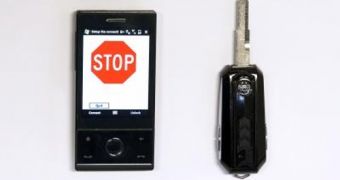The Key2SafeDriving system, devised by civil engineer Xuesong Zhou, an assistant professor at UU, prevents teenagers from talking or writing text messages on their cell phones while driving an automobile. Basically, it interferes with the phone's ability to send signals to the “outside” world, and forces it to display a “stop” sign on its screen at all times, during driving.
The key to the car is placed inside the new system itself, before the latter can be activated. Once inside, the key will force the emitter to send an “ok” signal to the cell phone, telling it that it can resume normal operations. The car can only be started if the key is slid out, and then the device sends a “busy” signal to the phone, either through Bluetooth, or through RFID (radio-frequency identification) technology.
Zhou says that the system cannot be tricked by turning off and reopening the mobile phone, because the device keeps emitting the stop signal the whole time the key is in the ignition. It's only when it slides back into the emitter that Key2SafeDriving disengages. Of course, there are some numbers that can be programmed into the phone so that they can be overwritten, such as 911 and, maybe, the parents' numbers.
"The key to safe driving is to avoid distraction. We want to provide a simple, cost-effective solution to improve driving safety. As a parent, you want to improve driving safety for your teenagers. You also want to reduce your insurance costs for your teen drivers. Using our system you can prove that teen drivers are not talking while driving, which can significantly reduce the risk of getting into a car accident," Zhou argues.
Previous studies have shown that talking or text messaging while driving are responsible for a 400 percent higher risk of drivers getting distracted from the road and getting involved in crashes or other accidents. This new system could be a first step in the right direction, and Zhou says that even adults could limit a part of their incoming calls while driving, so as to make the experience safer.

 14 DAY TRIAL //
14 DAY TRIAL //